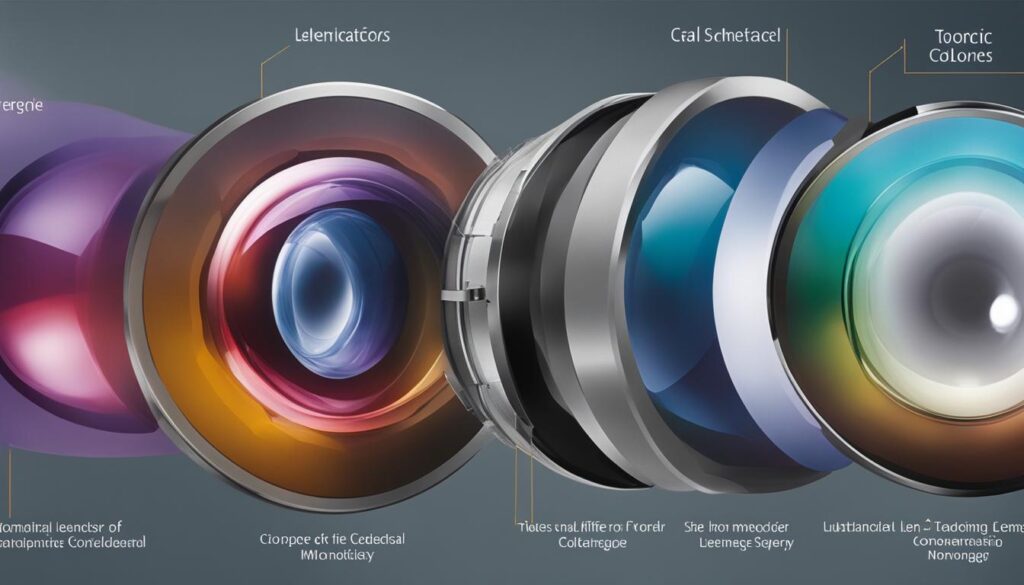
Understanding the different types of cataract surgery lenses can help you make an informed decision for vision correction. This guide covers cataract lens options, including monofocal, multifocal, and toric lenses, to assist in choosing the right intraocular lens (IOL) for your needs.
What Are Intraocular Lenses (IOLs)?
Intraocular lenses, or IOLs, are special synthetic lenses put inside the eye to replace the natural lens when it gets cloudy from cataracts. These lenses are super important for helping people see clearly again after cataract surgery. Knowing about IOLs can help patients choose the best options for their cataract treatment.
How IOLs Work
IOLs work by focusing light directly onto the retina. This helps create clearer images that you can see better. Unlike regular glasses or contact lenses that sit outside your eye and help you see indirectly, IOLs go right inside your eye. Because of this, many people find they can see better and don’t need glasses as much in their daily lives.
Materials Used in IOLs
The main materials used to make IOLs are acrylic and silicone. Each type has its pros and cons:
- Acrylic: This material is strong and gives great optical quality.
- Silicone: Silicone is more flexible, which makes it easier to put in but might have slightly different optical features.
It’s a good idea for patients to talk with their eye doctors about these materials to find out which one fits their needs best.
Cataract Lens Types- Exploring Your Options
Monofocal IOLs
Monofocal IOLs provide clear vision at just one distance—either near or far. They really help improve vision compared to having untreated cataracts, but many people still need reading glasses for close-up tasks after surgery.
Multifocal IOLs
Multifocal IOLs let you see clearly at different distances without needing extra glasses. They have different zones that help with seeing things up close or far away, like reading a book or driving. But getting used to these lenses might take some time as your brain learns how to switch between focus areas.
Toric IOLs
Toric IOLs are made especially for correcting astigmatism while also giving clear vision for either distance or near tasks. These lenses have different strengths in various parts of the lens so they can fit irregular shapes of the cornea better. This design helps improve overall vision quality for those who have astigmatism.
Understanding these types of intraocular lenses can guide patients toward making informed choices based on what works best for their lifestyle and visual needs.
Comparison of Major Types of Cataract Lenses
Side-by-Side Comparison
When looking at the major types of cataract lenses—monofocal, multifocal, and toric—it’s really important to know what each one offers.
- Monofocal IOLs: These lenses give you clear vision at just one distance, usually far away. They work great for folks who mainly need to see things like road signs or TV screens.
- Multifocal IOLs: These are designed with different zones that let you see well at various distances. If you like reading or doing crafts, a multifocal lens could be a good fit since it helps with both close-up and far-away views.
- Toric IOLs: These lenses are special because they correct astigmatism while also providing clear vision. They’re perfect for people who have astigmatism along with other vision needs.
Choosing the right lens really depends on your daily activities. If you’re often reading or doing tasks up close, a multifocal lens might be better. But if you mostly drive or watch TV, then a monofocal lens could be the way to go.
Performance Metrics
Performance metrics help us understand how well each type of cataract lens works:
- Clarity of Vision: This tells us how sharp your sight is after surgery. Different lenses can offer different levels of clarity.
- Range of Vision: Monofocal lenses are great for one distance, but multifocals let you see across a wider range—so they can help with seeing things up close and far away.
- Adaptability to Day and Night Settings: Some lenses work better in low light than others. Chatting with your eye doctor about what you do every day can help make sure you pick the right lens for your needs.
Cost Considerations
Cost is an important factor when picking between cataract lenses:
- Affordability: Monofocal lenses are usually the cheapest option and many insurance plans cover them, including Medicare.
- Insurance Coverage: Multifocal and toric lenses often cost more out-of-pocket because they use advanced technology.
Before deciding on a lens type, check with your insurance provider about what’s covered. Also, think about any future costs related to glasses or other corrective options that might come up later.
Choosing the Right Cataract Surgery Lens
Factors Affecting Lens Choice
Picking the best cataract surgery lens involves several key factors:
- Importance of Prescription Lenses: Your current prescription will greatly affect which intraocular lens (IOL) suits your needs after surgery.
- Impact of Existing Eye Conditions: Conditions like astigmatism or macular degeneration matter too. For example, if you have moderate to high astigmatism, toric lenses could be just what you need since they target that issue directly.
- Considering Lifestyle Factors: Think about what activities fill your day—whether it’s night driving or working on close-up projects like sewing—to guide your choice on which lens fits best into your life.
By thinking through these factors—like prescription needs and daily habits—you’ll be better prepared to choose the cataract surgery lens that works best for you.

Things to Consider When Choosing a Cataract Replacement Lens
Does Your Lifestyle Rely on Near Vision?
When picking a cataract replacement lens, think about how much you need clear near vision. If you enjoy reading, sewing, or working on a computer, having good near vision is key.
- Reading Glasses: Many people find they need reading glasses for tasks up close.
- Lifestyle Lenses: Some lenses are made to help with near vision.
Take a moment to look at your daily activities and hobbies. If you often do things that require sharp focus at close distances, choosing a lens that fits these needs is really important.
Do You Frequently Drive at Night?
Driving at night can be tricky and requires good visibility. Clear vision is super important when you’re navigating dimly lit roads.
- Night Vision Issues: Many folks struggle with glare and poor visibility while driving after dark.
- IOLs Best Suited for Night Driving: Certain intraocular lenses (IOLs) can help reduce glare and improve your sight in low-light situations.
Knowing the challenges of nighttime driving can help you pick the right lens type to address these issues effectively.
Do You Have Moderate to High Astigmatism?
Astigmatism can make seeing clearly more difficult. It happens when the cornea isn’t perfectly round, leading to blurry or distorted images.
- Diagnosing Astigmatism: An eye care professional can find out how much astigmatism you have through an eye exam.
- Best IOLs for Astigmatism Correction: Toric IOLs are specifically designed for correcting moderate to high astigmatism and improving overall clarity.
Choosing the right lens is essential if you have astigmatism since it directly impacts your daily comfort and visual clarity.
Existing Eye Conditions
If you have other eye conditions like glaucoma or macular degeneration, this might affect which cataract lenses are best for you. These health issues could change how different lenses work based on your unique situation.
- Eye Disease Compatibility: Some lenses may not be suitable if you have certain existing eye problems.
Talking with your eye care professional is crucial to ensure that the chosen lenses match both your health needs and visual goals. A detailed discussion about any current conditions will lead to better recommendations tailored just for you.
Importance of Consultation with Eye Care Professionals
Meeting with an ophthalmologist or cataract surgeon is important when selecting cataract surgery lenses. Professional guidance helps ensure you’re making informed choices based on expert knowledge.
- What Patients Should Expect During Consultations:
- Detailed evaluations of visual requirements
- Conversations about lifestyle factors affecting lens selection
- Overview of various IOL options available
Prepare questions about your specific needs during consultations. This back-and-forth helps clarify what to expect and deepens your understanding of the options available.
Summary of Key Considerations
Picking the right cataract replacement lens involves looking at many factors related to your lifestyle and visual needs. Here are some key points:
- Think about whether near vision is vital in your daily life.
- Reflect on night driving habits that might require special features in an IOL.
- Understand how astigmatism affects what kind of lens works best for you.
- Be aware of any existing eye conditions that could influence compatibility with certain lenses.
Taking time to reflect on these personal aspects while exploring different types of intraocular lenses will greatly assist in achieving better vision after cataract surgery.

Predictions and Future Developments in Cataract Surgery
Emerging Trends in Vision Correction
As technology improves, cataract surgery is changing fast. New intraocular lens (IOL) technologies are making it easier for people to see clearly without needing glasses. Here are some key advancements:
- Light-Adjustable Lenses: These lenses can be fine-tuned after surgery to fit your specific vision needs, giving you a more personalized experience.
- Extended Depth-of-Focus (EDOF) IOLs: EDOF lenses allow you to see well at different distances, so you won’t need bifocals or trifocals anymore.
- Accommodative Lenses: These mimic how your natural eye works, helping you focus on things both near and far smoothly.
- Premium IOLs: Designed to fix multiple vision issues at once, premium IOLs offer big benefits compared to traditional options.
These trends promise better results for patients, allowing them more freedom and flexibility in their daily lives.
Comparisons with Similar Technologies
Modern intraocular lenses are often compared to older methods like glasses and contact lenses. While these traditional options can fix problems like nearsightedness and astigmatism effectively, they have their downsides:
- Convenience: Glasses can get in the way during activities or sports.
- Comfort: Some people find contact lenses uncomfortable after wearing them for a long time.
On the other hand, newer IOL technologies aim to give greater freedom from needing corrective eyewear by combining multiple focal points into one lens. This means clearer vision without the hassle of switching between different types of glasses or contacts.
Conclusion and Call to Action
Understanding the different types of cataract surgery lenses—monofocal, multifocal, and toric—is important when deciding about your eye health. With new technologies coming out all the time, patients now have many options for restoring their vision effectively.
If you’re thinking about cataract surgery or want to know more about your lens choices, it’s best to talk with an experienced ophthalmologist. They can help you choose the right lens based on your unique needs.
Helpful Resources
For anyone looking for more information about cataract surgery or personalized advice:
- Check out further reading links online about various cataract surgery options.
- Contact qualified eye care professionals who can provide tailored recommendations based on your situation.
These resources will help prospective patients access valuable information as they make decisions regarding cataract surgery.
